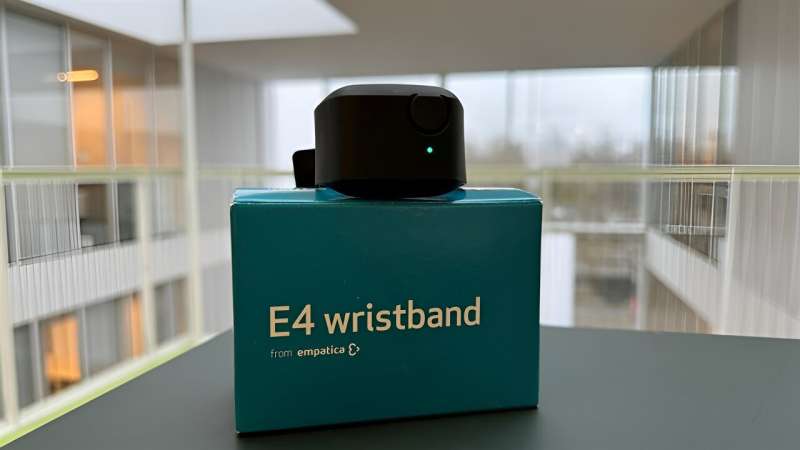This article has been reviewed according to Science X's editorial process and policies. Editors have highlighted the following attributes while ensuring the content's credibility:
fact-checked
trusted source
proofread
AI wristband may be an effective tool in future child and adolescent psychiatry

Together with researchers from the Mental Health Services of the Capital Region of Denmark, a group of DTU researchers have developed and tested the Wrist Angel wristband, which uses artificial intelligence (AI) to predict whether a person with OCD is nearing an obsessive thought episode.
The wristband achieved 70% accuracy during a pilot trial, and the team behind it hopes that it can also be used by people with other diagnoses—such as stress and anxiety—in the future.
The wristband looks like a common sports watch. It measures the child's heart rate and sweat production and runs this data through an AI model that can predict whether an OCD episode (obsessive thoughts or actions) is looming. When an episode is underway, the child and their parents can receive a message that makes them aware of this. This allows the child to do preventive exercises that they have been taught by their therapist.
One of the treatment methods for OCD is to confront your obsessive thoughts and actions rather than trying to shield yourself from them in daily life.
"It could be that the child has difficulty touching a handle due to fear of bacteria. The wristband reminds the child and parents to practice working with that challenge. While the child does exercises at the clinic, studies show that practicing at home, where the problems most often occur, is quite effective. The wristband also offers a monitoring option for the therapist, who can get feedback on how often the child has OCD episodes," says Line Clemmensen, Professor at DTU Compute and the project coordinator.
Much more work to do
Together with the Child and Adolescent Mental Health Center at the Capital Region of Denmark, researchers looked at whether the wristband can help children suffering from OCD and their families. Nine children and adolescents aged 10–17 years wore the wristband for eight weeks.
"While we had quite good accuracy at 70%, we also became aware of some challenges that we can take into account in our further development. One of the project participants did not want to wear the wristband due to obsessive thoughts about bacteria that could be on the wristband. The wristband may therefore not be suitable for all children suffering from OCD. But we are very optimistic after the pilot trial, and we can see that it makes sense to continue working with this tool," says Line Clemmensen.
Down the road, the researchers also see potential for the wristband to be used with other diagnoses.
"The symptoms our wristbands measure typically also occur in people with diagnoses other than OCD. This type of wristband has previously been used to detect stress, but under very controlled conditions. So our wristbands will need to be tested on a larger scale outside these controlled settings. Anxiety could also be a focus. This is definitely something we want to investigate further," says Line Clemmensen.
Exercise or obsessive thoughts?
When heart rate rises and sweat forms, it can be difficult to tell whether these are signs of an obsessive thought episode or if the child is simply exercising. There is a therefore a risk that the wristband will generate false alarms. The challenge of detecting the difference between physical activity and OCD symptoms resulted in a number of such false alarms during the pilot. The bracelet has therefore now been equipped with an activity meter to address this challenge.
"An accelerometer has been built in to measure acceleration in three dimensions. This works in the same way as when your smartphone measures the number of steps you've taken in a day. This allows the AI model to see whether the high heart rate is due to exercise or whether an OCD episode is on the way," says Line Clemmensen.
Data is crucial
While the results of the pilot show the wristband holds good potential, there is still some way to go before Wrist Angel can become a regular tool used among children and adolescents with OCD. For the AI model on which the wristband is based to become even more precise in its calculations, large amounts of data must be collected from people with OCD, to train the model and improve its predictions.
"We currently have only a small amount of data, and therefore need to seek funding for a larger study. Our hope for the technology is that it will give therapists more time with the child. By clearly monitoring the child's OCD episodes, the therapist can avoid a lot of paperwork and questions about the number of episodes, which can also be difficult for the child to remember and keep track of," says Line Clemmensen.


















